Nine Mile Canyon is an off-the-beaten-path destination close to Price, Utah. It’s perfect for RV travelers looking for history, active travel, and outdoor adventures. Commonly referred to as “the world’s longest art gallery,” 9-Mile Canyon is renowned for its collection of petroglyphs (rock art). You need to add this trip to your RV travel adventures bucket list!
Disclosure: This post contains affiliate links. If you buy something from one of our affiliates, we receive a small commission at no extra charge to you. Thanks for helping to keep our blog up and running!
Table of Contents
Utah’s Nine Mile Canyon Petroglyphs
Where exactly is Nine Mile Canyon? Why is it famous for petroglyphs? And how is it unique? Let’s explore!
What and Where Is Nine Mile Canyon?
Nine Mile Canyon sits in east-central Utah, just minutes southeast of Price, or a two-hour drive from Salt Lake City. Named for a nine-mile triangulation point marked by Major John Wesley Powell in 1872, the canyon stretches over 40 miles, but the original name stuck.
In 1886, the U.S. Army’s Buffalo Soldiers built a road through Nine Mile Canyon, creating a freight route between Fort Duchesne and the railroad. Later, it became a key route for transporting gilsonite, a rare mineral used in products like paint and chewing gum.
Settlers moved into the valley and Nine Mile Canyon’s prehistoric treasures became known to the outside world.
Unique Rock Art in Nine Mile Canyon
Nine Mile Canyon’s rock art, created by the Fremont and Ute cultures, is the big draw. There are three basic types of rock art found in the United States: carving on stone (petroglyphs), painting on stone (pictographs), or laying out rocks on the ground in patterns (geoglyphs). Both petroglyphs and pictographs are found in Nine Mile Canyon.
With 663 rock art sites, Nine Mile has one of Utah’s highest densities of ancient rock art, showcasing life here between 950 and 1250 AD.
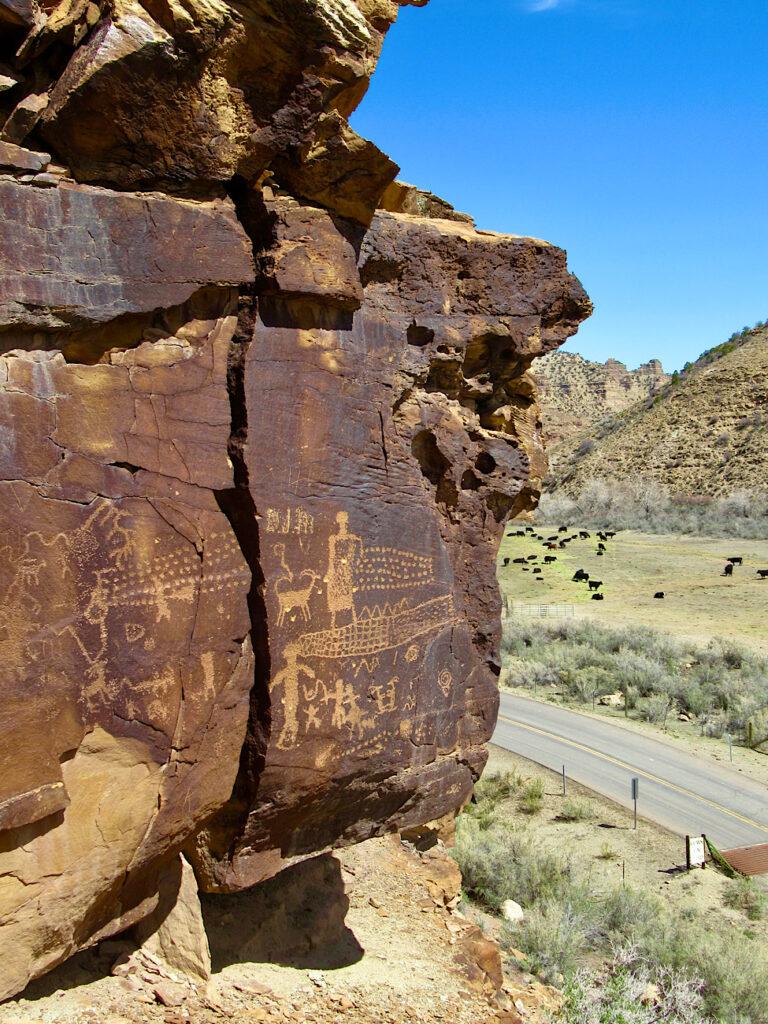
Wondering how to begin to plan an RV adventure like this?
Check out our step-by-step post for RV travel planning.
RV Travel Adventures in Nine Mile Canyon
Our recent trip back through southern Utah took us to Nine Mile Canyon. After grabbing a map and QR code for a self-guided mobile tour, we set off to discover what new sights awaited us!
At the summit of Soldier’s Pass, the road passes through Whitmore Park. In the past, horse-drawn wagons left Price loaded with supplies destined for Fort Duchesne and the soldiers stationed there. Heavy snow accumulation at the pass required extra “helper” horses to pull the wagons up to the pass before beginning to drop into Nine Mile Canyon just up the road.
Towing our trailer, we climbed to 7,500 feet over the pass, grateful for our truck’s horsepower. We reached Nine Mile Ranch, the only campground in the canyon, where we set up camp. While the amenities are basic, it’s a great spot for exploring the canyon’s rock art sites.
It’s now time to start touring Nine Mile Canyon, finding petroglyphs, old homesteads, and picnic stops along the way.
First Site
While this site is not the most spectacular one in the canyon, is a good introduction to petroglyphs and pictographs and the permanent impact of rock art vandalism. Head across the road from the pullout towards the rock face to see the art.
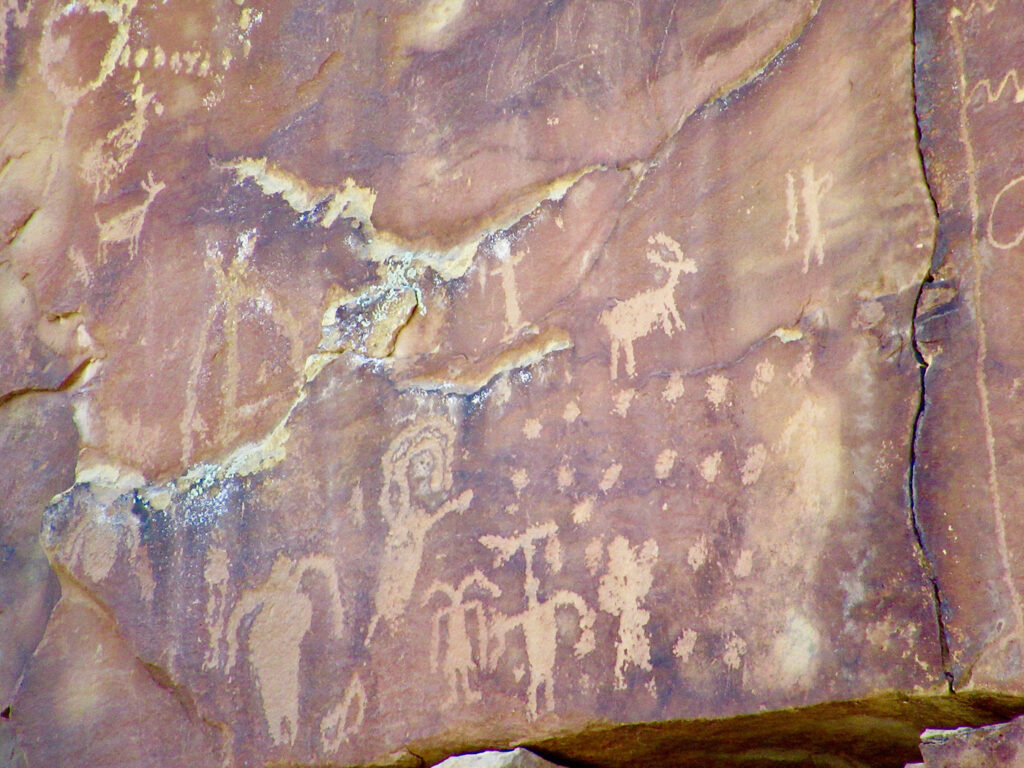
Cottonwood Glen Picnic Area
A nice pull-off with restrooms and a chance to see remains of a historic homestead. This site was once part the Christensen Ranch. Original settled in 1896 by George C. Johnstun, Tom Christensen bought the property in 1945.
The old cabin that remains shows two building periods with an older section dating to the late 1800s. You are welcome to walk through the cabin to get a closer look.
Pig-head Balanced Rock
Just past Mile 32, the Pig Head is one of the most recognizable geologic formations in the canyon – mainly because it’s a balanced rock. Try as we might, we couldn’t quite see the pig head! Still an impressive sight, it’s also home to another rock art panel close to the ground. The main petroglyph figure in this art panel has been referred to as a “balloon man” or “the Juggler.” Look up along the cliff faces nearby for more petroglyphs.
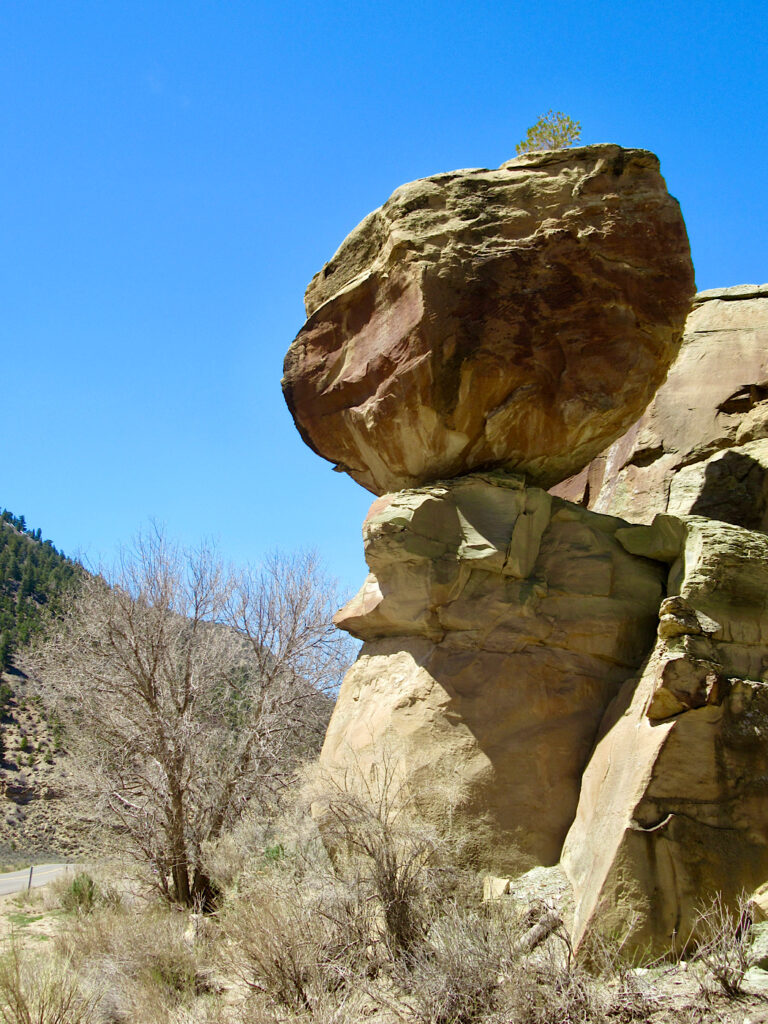
Coyote Placing Stars
In this Fremont-style panel, the central figure is standing upright and appears to have a wolf or coyote head and a bag hanging under its arm with the moon on a string. There are dozens of dots, which could be the stars. A distant view of the area shows there are stars below and above Coyote and filling adjacent sandstone panels.
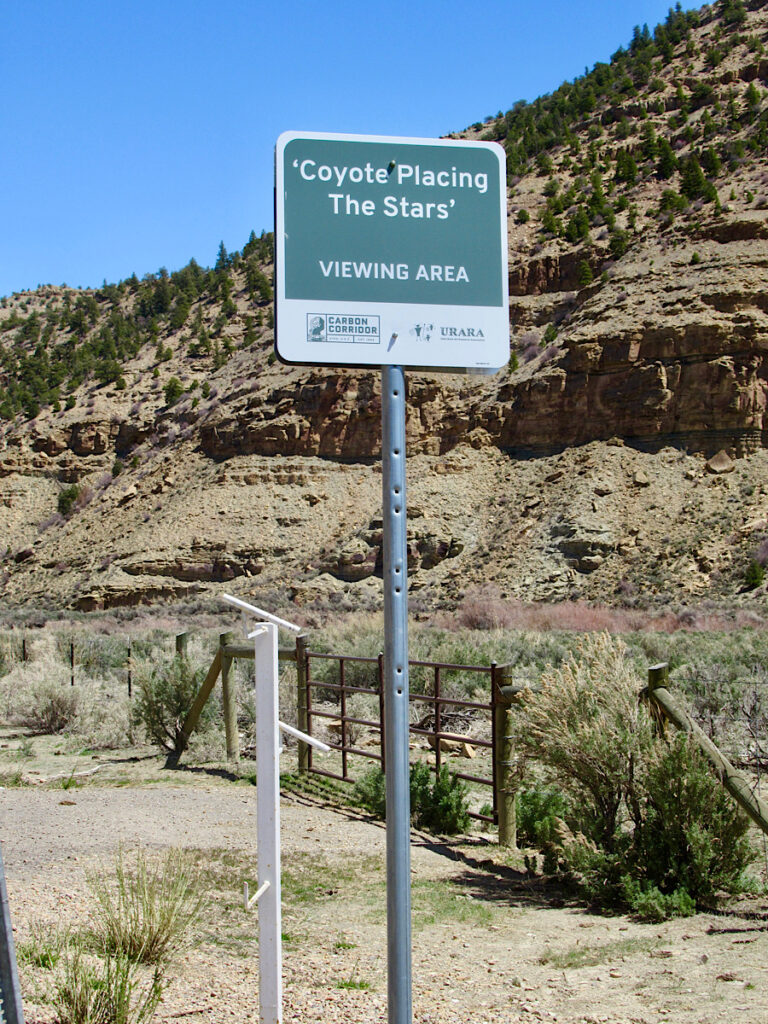
Owl Panel
You can’t miss the cross-eyed owl, bear track, and a grizzly bear in the upper left-hand corner. It’s thought that this panel was created by Ute tribes. There is a small human figure riding a horse on the lower part of the cliff, suggesting it was created some time after 1680 when horses were introduced.
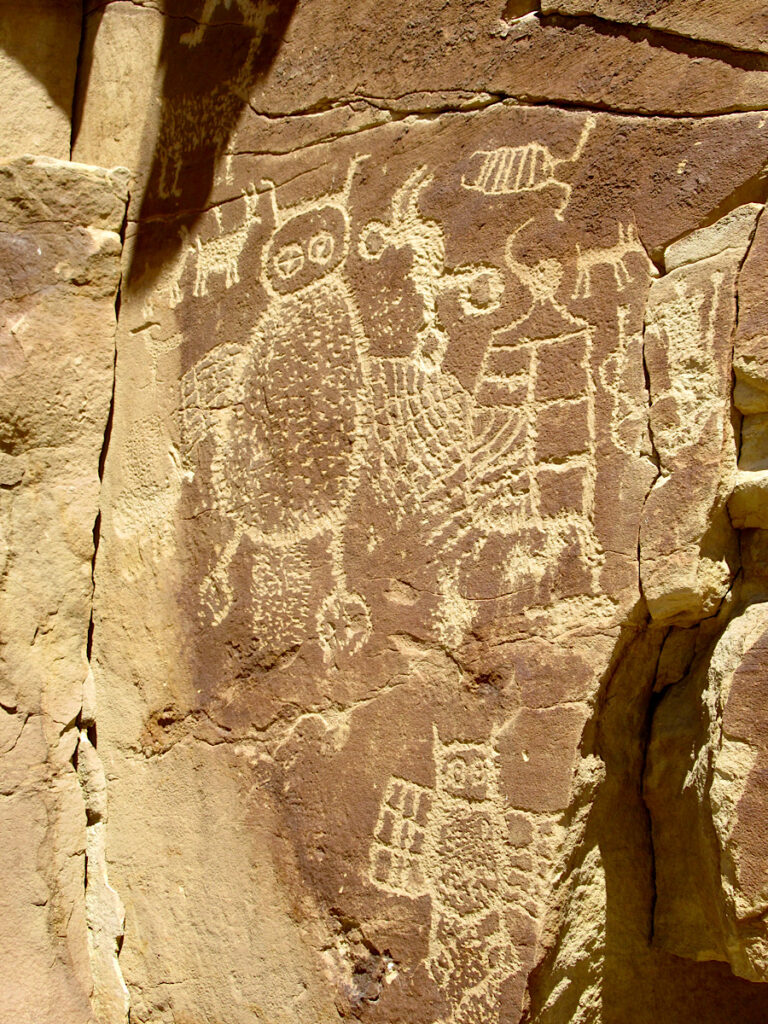
The panel might depict the annual Ute Bear Dance, held each spring following the first thunderstorm of the year – a tradition that began in the 15th century. According to Ute mythology, bears taught humans the dance. Be sure to follow the cliff and another social trail back out towards the road for more petroglyphs.
Rasmussen Cave
Rasmussen Cave was on private property for many years. The BLM now owns the property due to a land trade with the landowner. It is legal to visit. This is one site guaranteed to have you shaking your head – don’t miss it!
Rasmussen Cave was first studied starting in 1929, followed by illegal digging by pot hunters and countless sanctioned archaeological digs. Numerous artifacts were found. It’s not untouched. In fact, Rasmussen Cave is a poster child for how not to treat rock art.
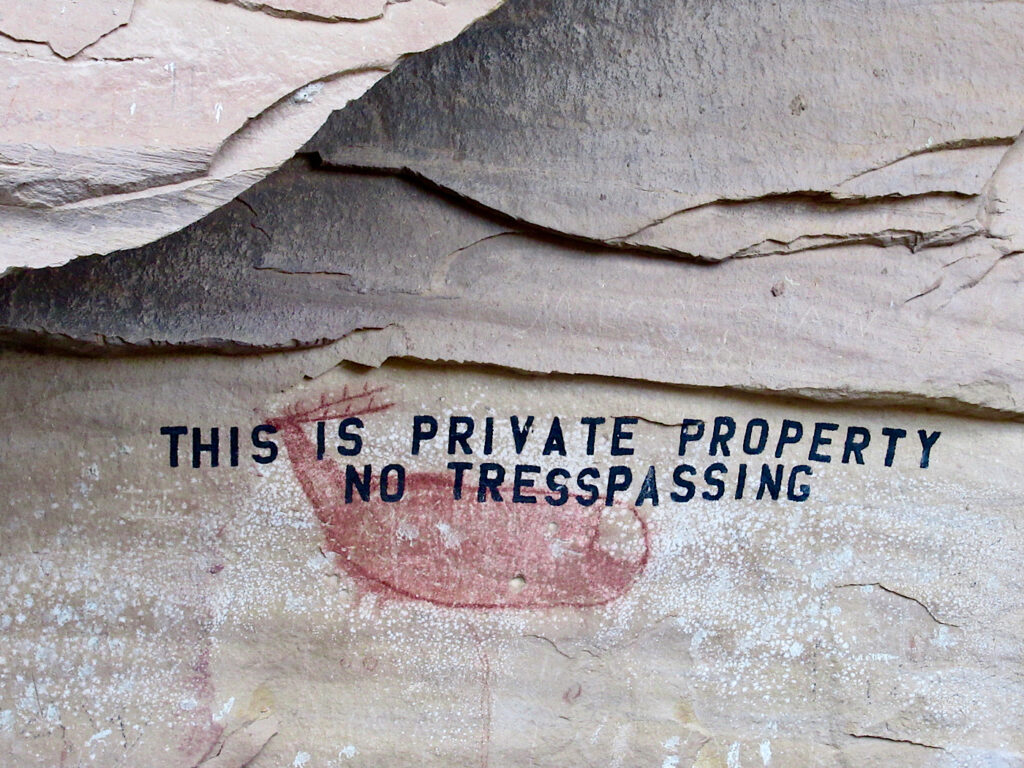
Daddy Canyon
The next signed stop is the Daddy Canyon.
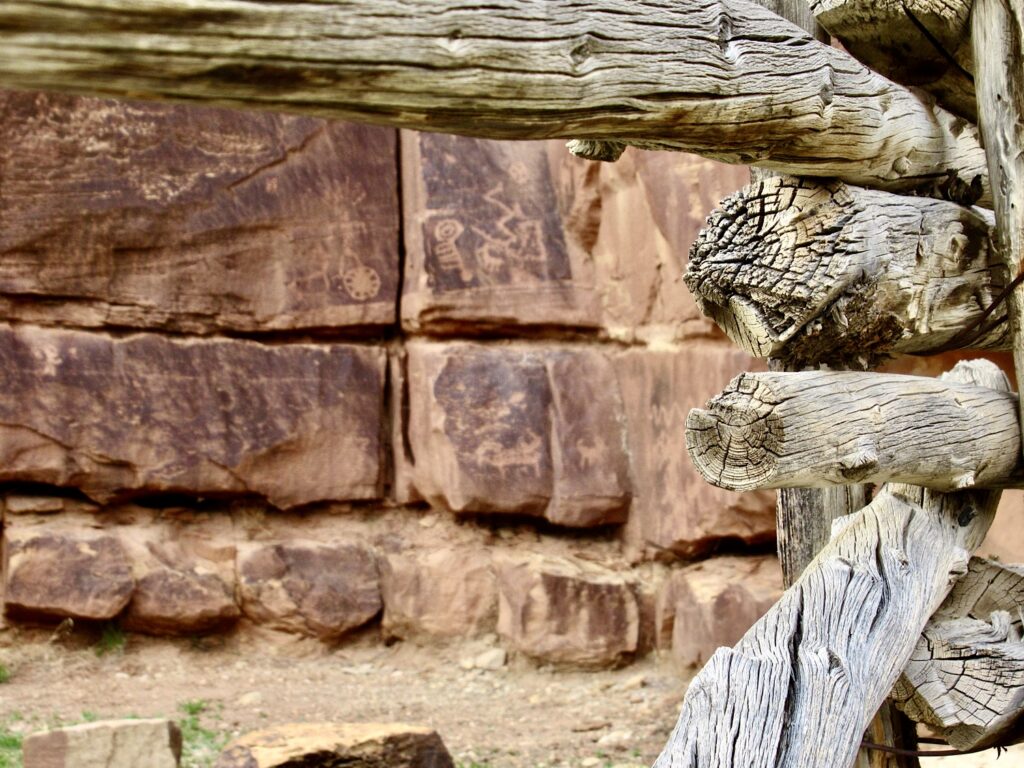
A walking trail along the north side of the cliffs leads to Fremont and Ute rock art panels. One of the panels features elk figures being pursued by Native American warriors on horseback with riderless horses in tow – depicting a Ute elk hunt.
Freemont Village
The signed pullout allows access to a short trail climbing to the remains of an old village. Excavated in 2019, you can see remains of walls, boulders with open cave areas underneath, and structures across the canyon (if you have binoculars).
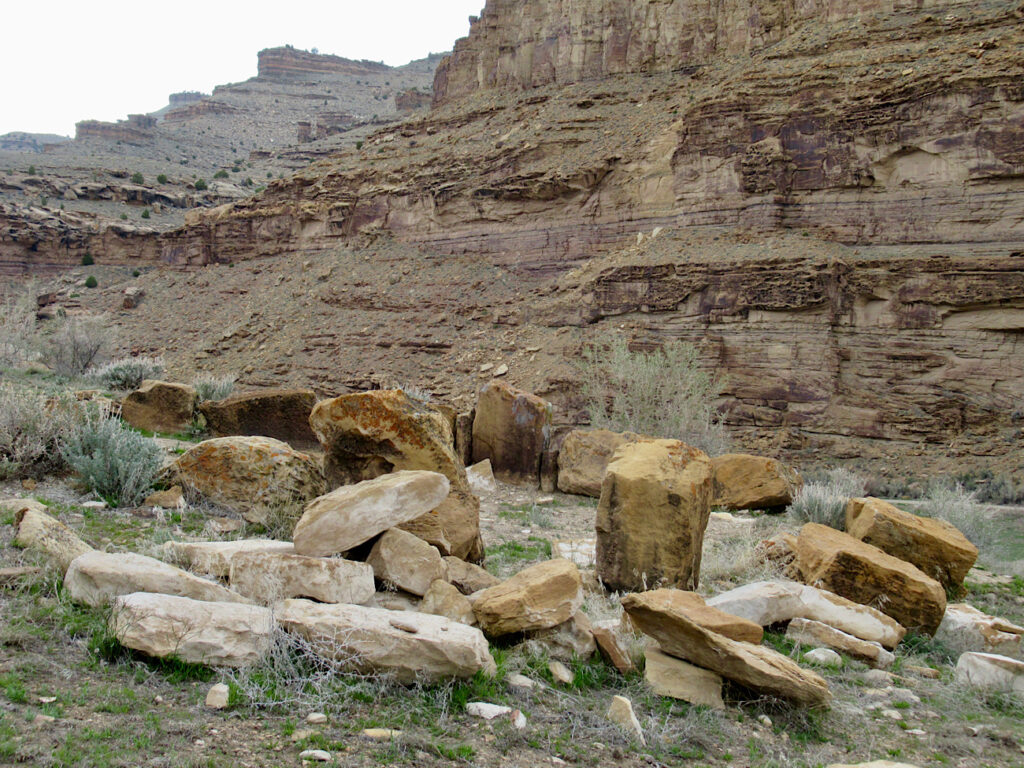
Big Buffalo Panel
The Big Buffalo Panel pull-out is on the left side of the road. From the parking area, the trail crosses Cottonwood Wash (completely dry when we visited) before heading to the petroglyph panel.
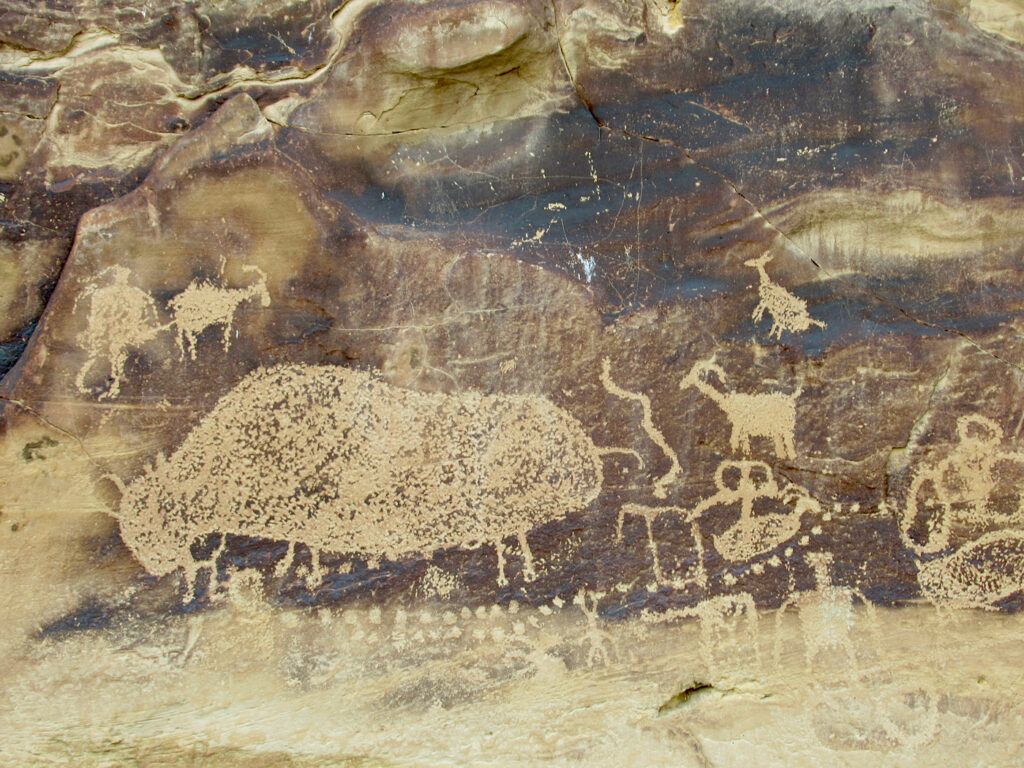
Nearby is the pregnant buffalo petroglyph. Much of the panel appears to be created by Ute tribe. It includes a man on a horse with two pack mules following behind. The image of the man on horseback is rare in eastern Utah. The mules seem to have pack saddles on their backs. This panel also includes the earliest historic date of August 19, 1867, as well as the name S. Groesbeck.
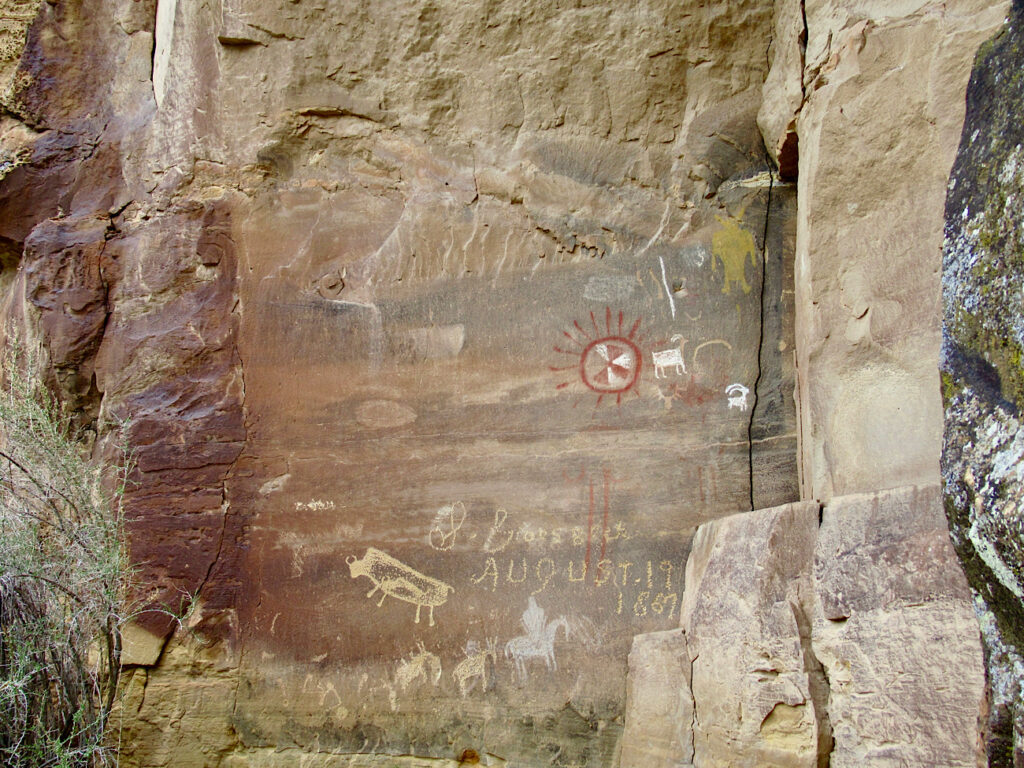
The images in this rock panel are well-defined. The red and white shield is vibrant and the yellow human figure (called an “anthropomorph”) stands out above.
Great Hunt Panel
Our final stop was the Great Hunt panel. From the parking area, it’s a short walk down the trail to the petroglyphs. The Great Hunt panel is one of the most famous rock art panels found in Utah because its execution, detailed design, and well-preserved condition. There are five petroglyph panels depicting religious and hunting scenes.
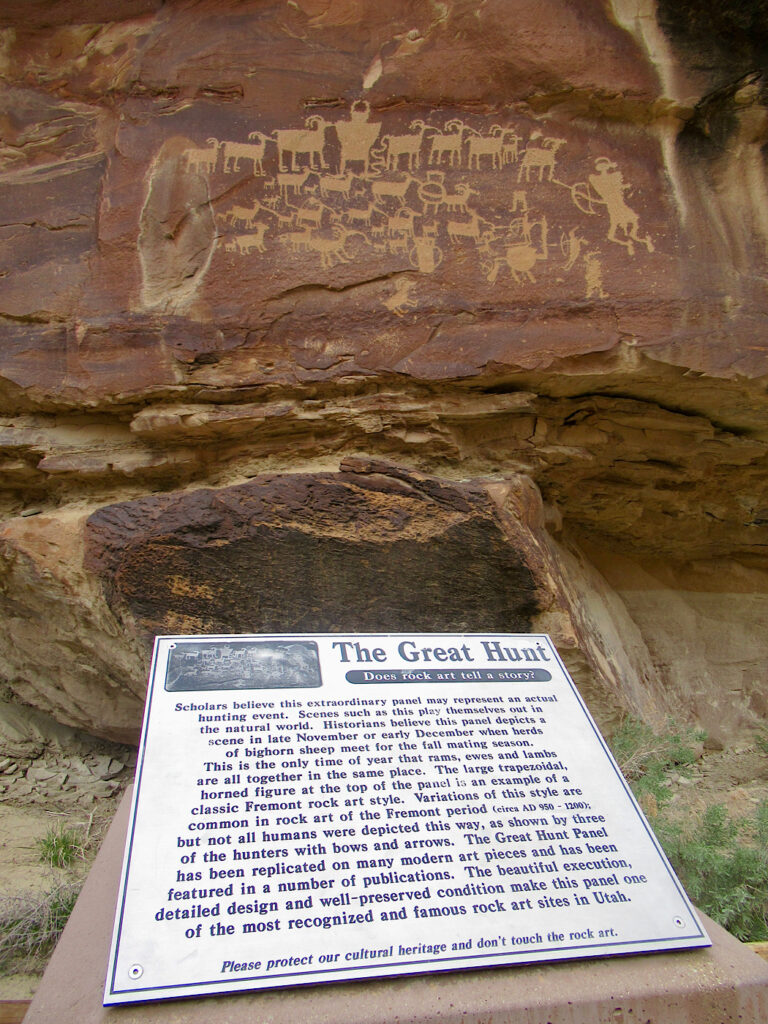
Variations of this style are common in rock art of the Fremont period (circa AD 950 – 1200). Obviously, not all humans were drawn this way, as can be seen with three of the hunters with bows and arrows in panel.
Nine Mile Canyon is an open-air gallery of ancient art, free to all visitors. Remember, much of the canyon’s land is private; always respect property lines.
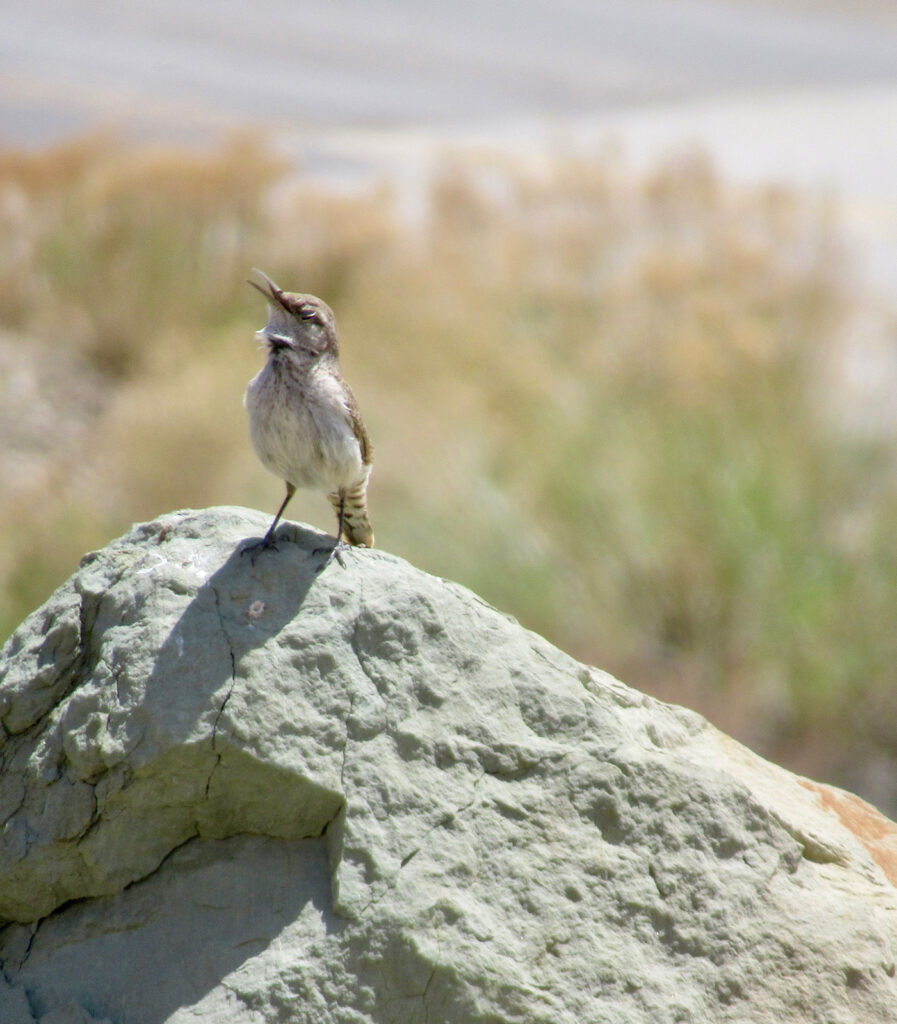
Visiting Tips for Utah’s 9-Mile Canyon
Plan your trip for May to October to avoid snow. Use Nine Mile Road, which turns off by the gas station in Wellington onto Soldier’s Pass Road. Respect all signage, keep off private land, and never touch rock art—natural oils from skin can damage these ancient designs.
You can find a map of Nine Mile Canyon on the BLM website. For a list of mileages and additional rock art and cultural sites in the canyon, check out the post from Road Trip Ryan.
Want to learn more about 9-Mile Canyon? Check out these books:
Nine Mile Canyon: The Archaeological History of an American Treasure
Horned Snakes and Axle Grease
Nine Mile Canyon (Images of America).
Want to visit more petrogplyh sites? Check out Quail Creek State Park in southern Utah or get this checklist of petroglyphs and pictographs and cultural sites in nearby Arizona!
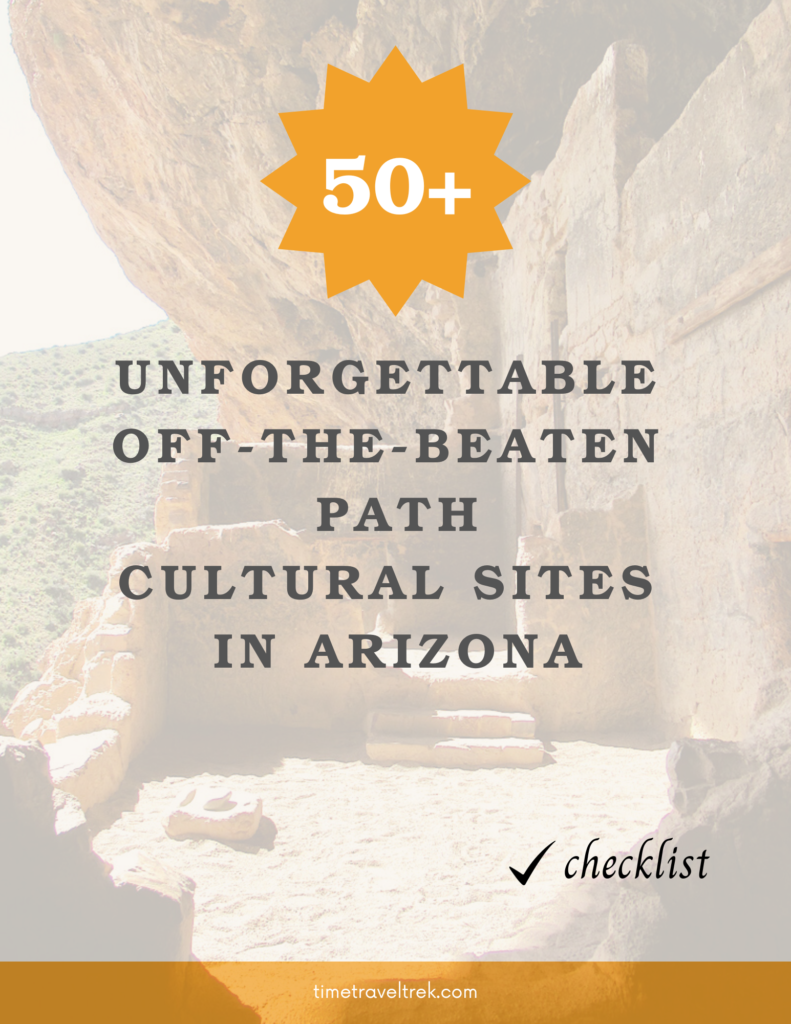
If you love petroglyphs and pictographs and cultural sites, check out our checklist of unforgettable, off-the-beaten-path cultural sites in AZ – available in our Etsy shop!
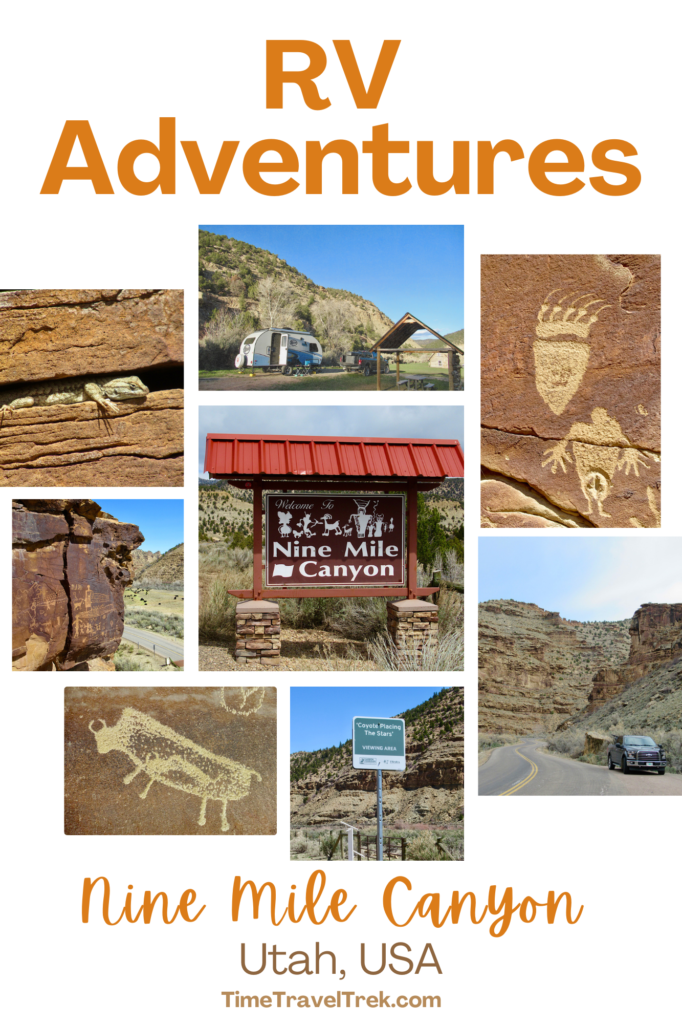
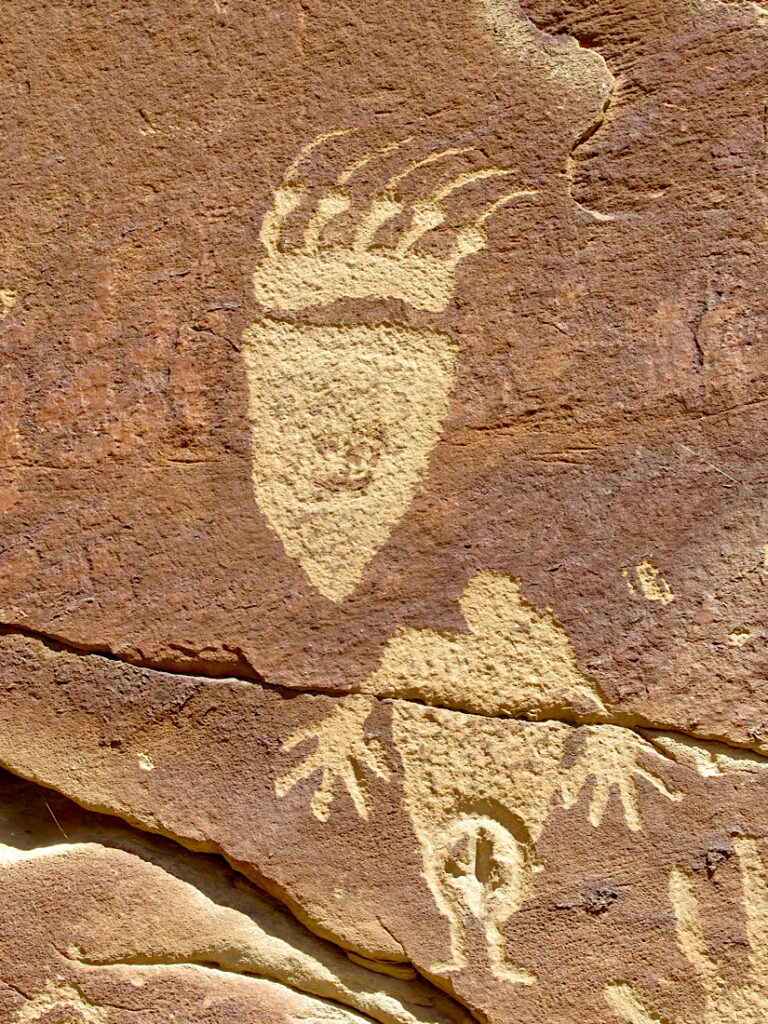
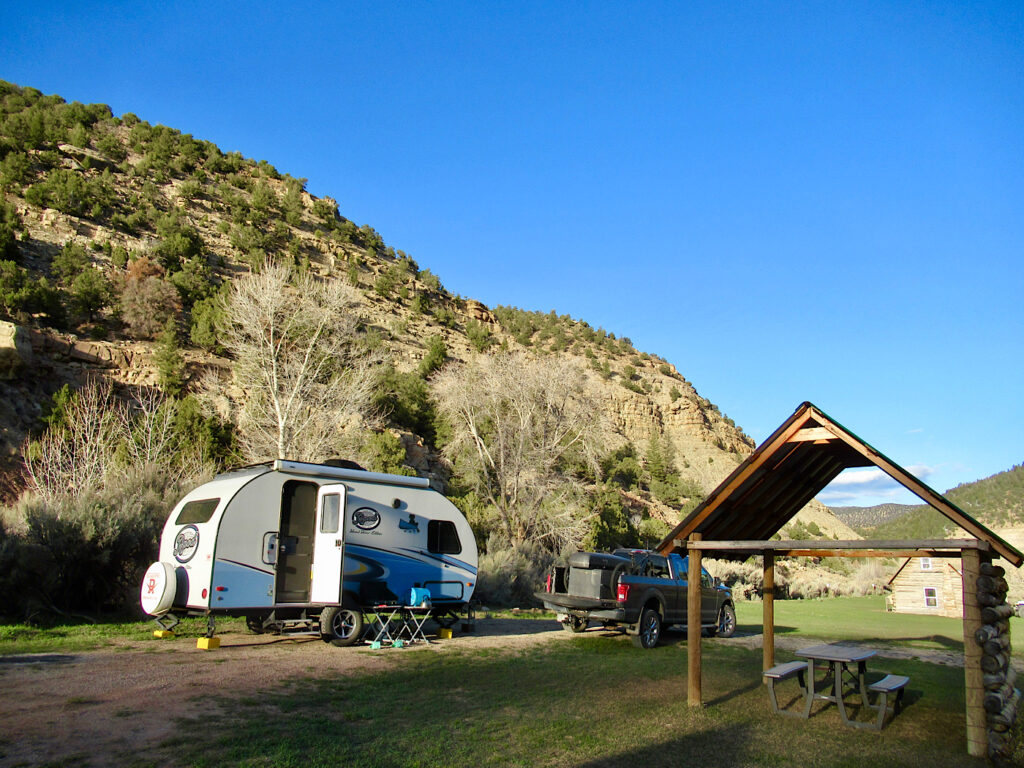
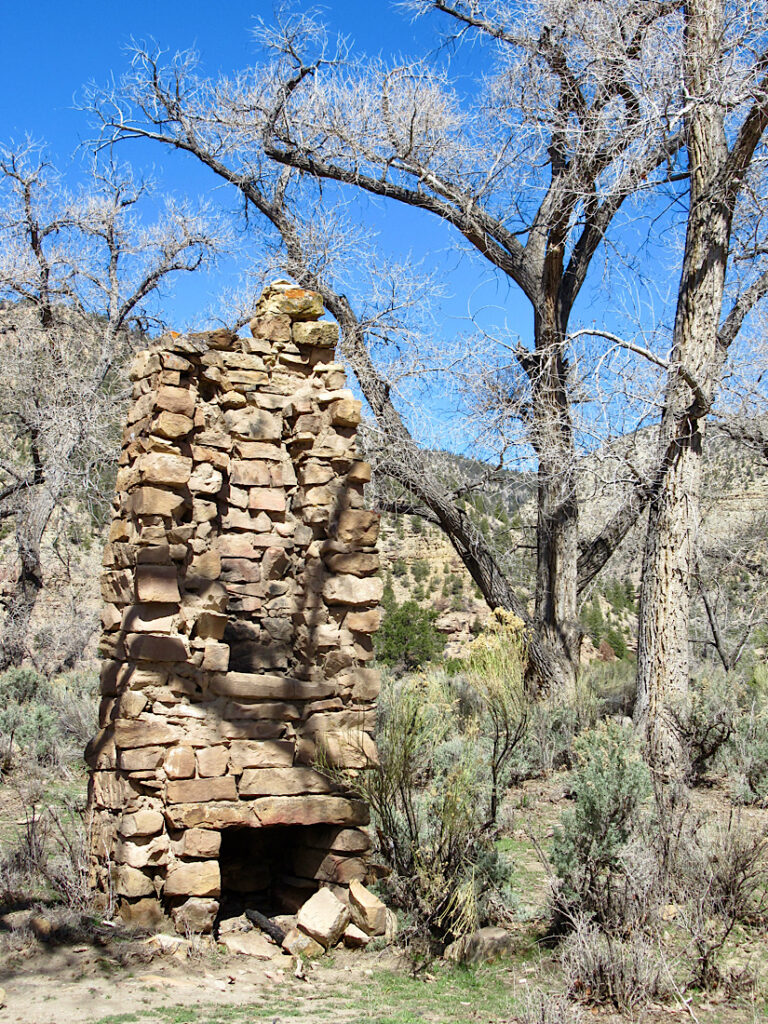
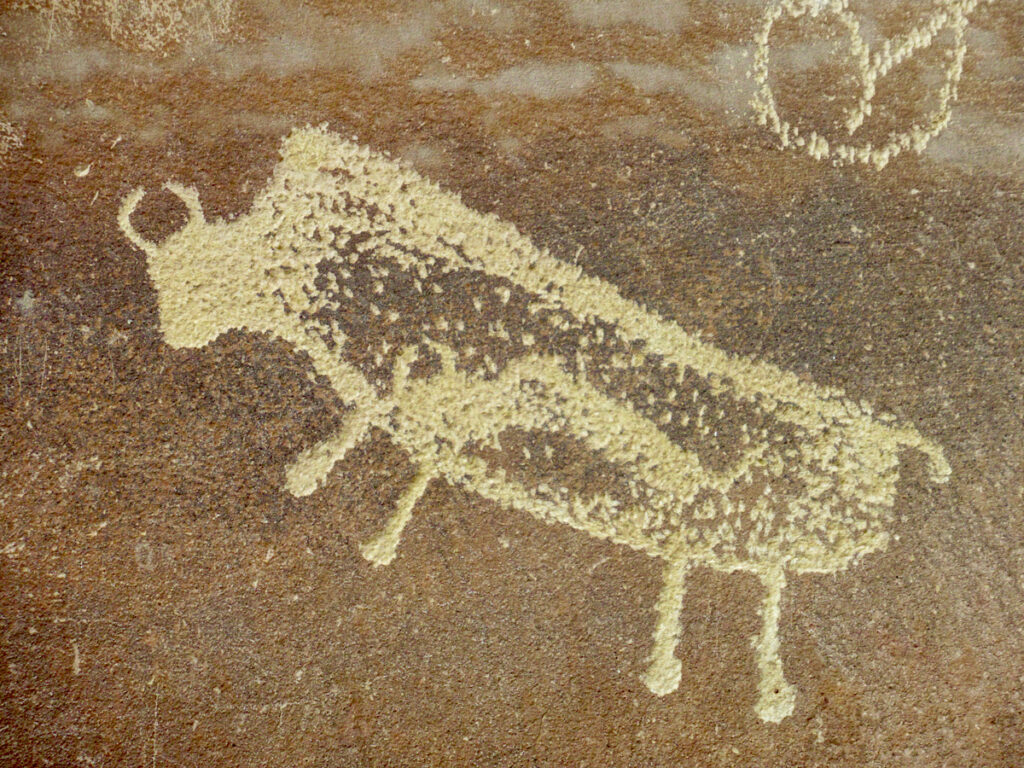
Leave a Reply